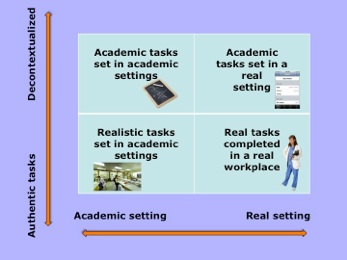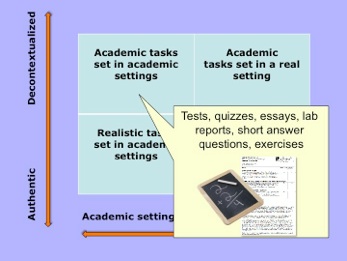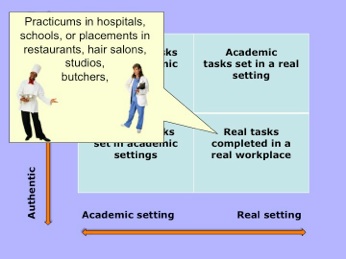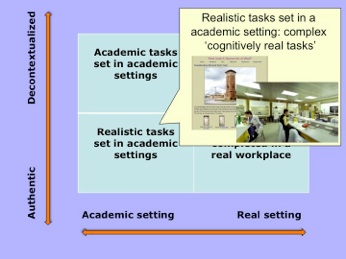A matrix of Authentic learning
Real or realistic; authentic or academic?
Can a learning environment be
called authentic if it is completed in a classroom or on campus? Yes,
we think so! Authentic does not necessarily mean real (as in practicums
and internships). As a pedagogical model, authentic learning means that
realistic tasks set in academic settings can challenge students to think
and solve problems just as professionals do in the real world.
Video: 3:27 minutes
More Reading:
- Herrington, J., Reeves, T.C., & Oliver, R. (2007). Immersive learning technologies: Realism and online authentic learning. Journal of Computing in Higher Education, 19(1), 65-84.
- Herrington, J., Oliver, R., & Reeves, T.C. (2003). Patterns of engagement in authentic online learning environments. Australian Journal of Educational Technology, 19(1), 59-71.
- Petraglia, J. (1998). Reality by design: The rhetoric and technology of authenticity in education. Mahwah, NJ: Lawrence Erlbaum Associates.
AUTHENTIC LEARNING HAPPENS IN CLASSROOMS!
If you think about the types of tasks and their settings, it helps to
see where authentic learning is situated. In this matrix, the authenticity of the task is on one axis (from authentic to decontextualised), and the setting is on the other (the classroom/university to the real setting).

QUADRANT 1:
Academic tasks set in academic settings
Most educational tasks probably fit into this quadrant, where teachers set questions, essay topics, exercises, quizzes and tests for students to complete in the educational setting - the university or school classrooms.

QUADRANT 2:
Academic tasks set in a real settings
In this quadrant, tasks are generally set by the teacher, and they are completed in a real setting,
such as a worksheet on an excursion to a factory or on a field trip, or
set tasks for students to complete while on internship or practicum.

QUADRANT 3:
Real tasks completed in a real workplace
Most practicums and internships occur in this quadrant where pre-service professionals engage in the practices of the profession in the real workplace.

QUADRANT 4:
Realistic tasks set in an academic setting
This is what we mean by authentic learning (and what this website is all about!). It means realistic and complex tasks that can be completed in classrooms and educational institutions, giving students important opportunities to think as professionals!
